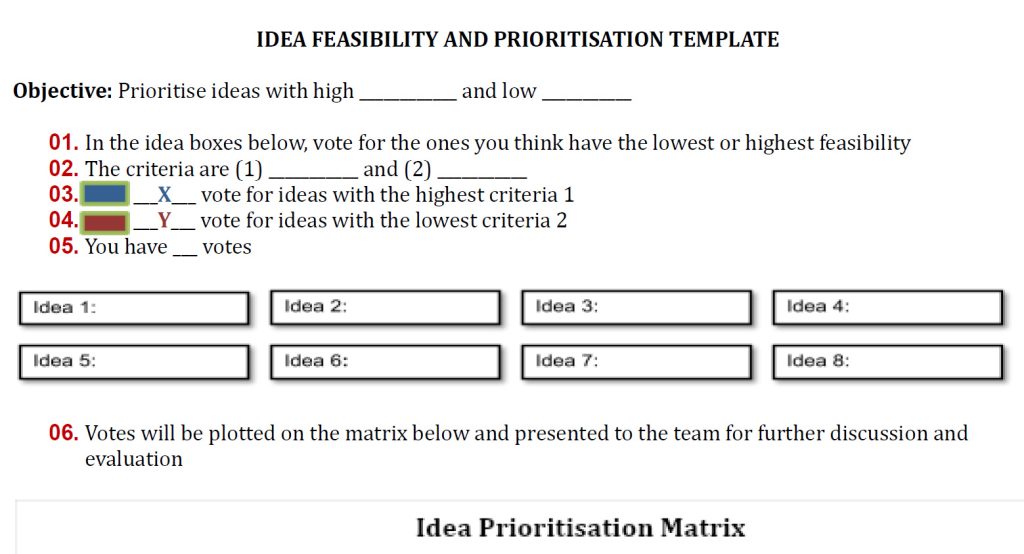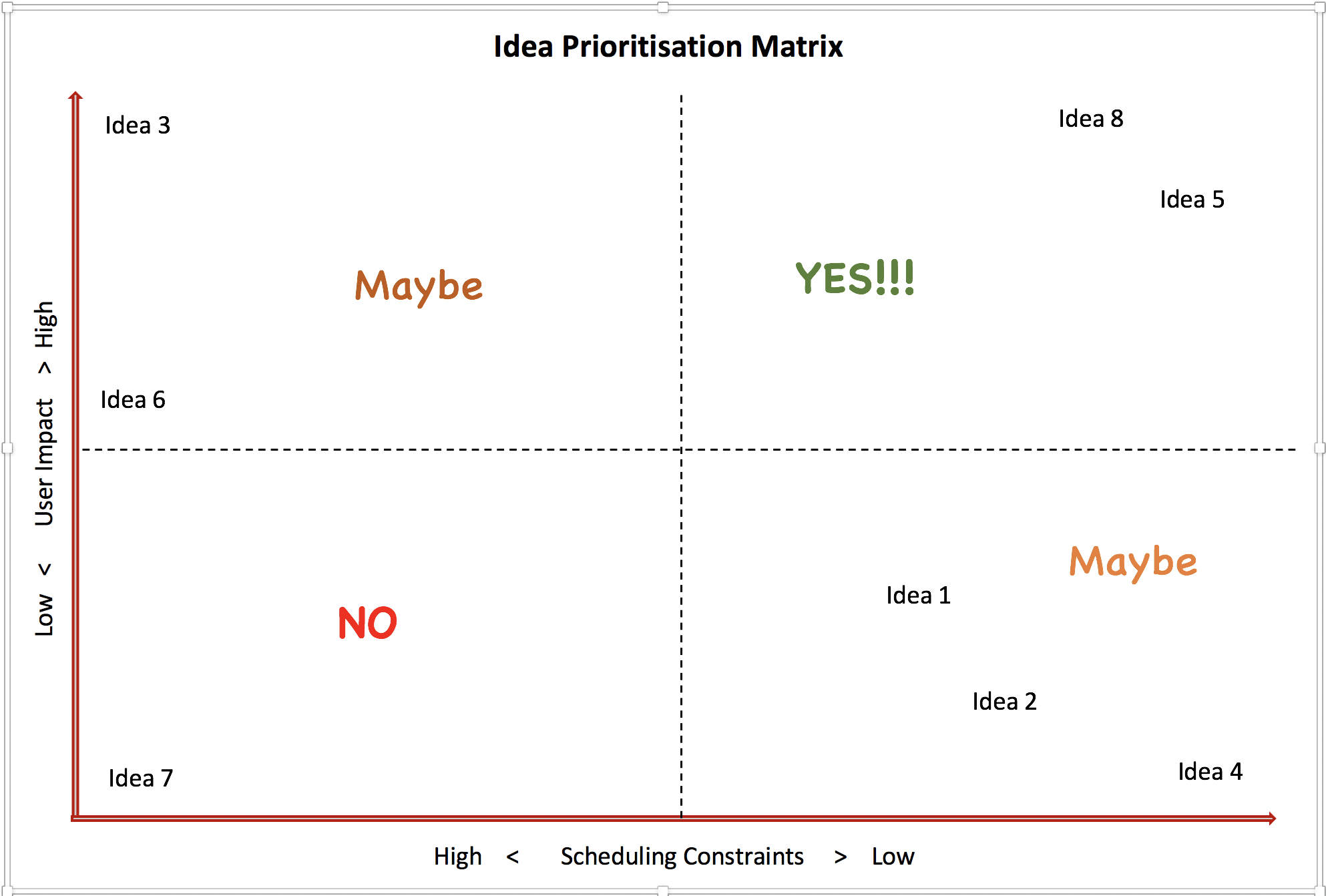We are an award winning product design consultancy, we design connected products and instruments for pioneering technology companies.
Free idea feasibility template to help you make informed decisions
Reading time 7 mins
Key Points
- When you’ve got a lot of ideas, projects, or tasks on your plate and need to decide which to ingest first, prioritisation is key
- Use our idea feasibility template to help make informed decisions and ensure you’ve taken the relevant factors into consideration
- A 2×2 prioritisation matrix is a simple but effective way to evaluate, compare, and contrast ideas based on two criteria (e.g. user impact and scheduling)
- When shared with your team, it’s a powerful collaborative tool that can help you reach an interdisciplinary consensus and avoid Groupthink
- Free to download and easily customisable to suit a range of different purposes
Ready to start developing your new product?
Call us for a quote!
Ben Mazur
Managing Director
I hope you enjoy reading this post.
If you would like us to develop your next product for you, click here
In our previous post on brainstorming and creativity, we looked at how using a template based on the SCAMPER method can help teams to generate ideas quickly and collaboratively. The next step, making informed decisions on which to pursue for more research and validation, can be overwhelming if you’ve got a lot of ideas on your plate. Download this idea feasibility template to help you prioritise the ones with the most potential.
 Idea Feasibility Template
Idea Feasibility Template
Download this free template.
Also known as a prioritisation matrix, this simple but powerful tool will help you to:
- Prioritise ideas based on two criteria, e.g. importance or urgency
- Maximise your time by ensuring you’re always working on the most important tasks and know which ones to delegate, shelve, or eliminate
- Compare and contrast different ideas
- Use a structured and objective approach to achieve a collaborative consensus
How to use a prioritisation matrix template
Designers, product engineers, and even entrepreneurs often get caught up in a balancing act: improving the user experience, developing new ideas, managing resources etc. Nobody can do everything simultaneously, so simple tools that help us to visualise priorities are essential.
Step One: Identify the criteria and scale you’ll use
Use this 2×2 matrix template to prioritise a range of criteria, from projects or tasks that need doing; to research activities or features you plan to implement. The first step is to define your criteria.
For example, when using it as an idea feasibility template, the criteria could be ‘user impact’ on one axis and ‘scheduling constraints’ on the other. If used as a time management tool, the requirements could be ‘importance’ on one axis and ‘urgency’ on the other.
Regardless of the items you’re prioritising, the criteria should always be based on the project’s overall goals, or your business or personal needs. For example, prioritise ideas with high user impact and low scheduling constraints.
Once you’ve listed your ideas and evaluation criteria, develop your scale. The scale can be as simple as high-low or actual numbers (e.g. 1-100 if your ranking is percentage based).
Step Two: Allocate and vote
Make a list of the ideas that need prioritising.
Allocate everyone on your team with a different colour dot/mark to represent their area of expertise and get them to vote for the ideas they think have the strongest potential. For example, on a matrix plotting scheduling feasibility vs impact on the user, developers can be assigned blue and put their mark against ideas that are the most feasible in terms of scheduling, while designers can put an orange mark against the ideas with the highest user impact.
A general rule of thumb is the number of votes per person is half the number of ideas being prioritised. These votes should be educated opinions, so you should give your team time to research or investigate before voting. The added benefit of making this a collaborative process and giving everyone on your team a chance to vote is that you’ll get a cross-disciplinary consensus which is integral to success.
As this step can be time-consuming, consider sending the list to all team members in advance and getting them to vote privately/digitally before bringing them together for step three. This will make it easier for remote workers to participate and prevent ‘Groupthink’ (when the desire for group consensus overrides critical thinking) or the loudest person in the room from dominating.
Step Three: Use our feasibility template to plot your findings, discuss, and negotiate.
Using your team’s votes as a guideline, place each idea on its corresponding grid, discuss the results, and compare where ideas fell. Some questions to ask to help re-negotiate idea placement:
- Are ideas that received the same number of votes equally feasible? Why, or why not?
- Is everyone in agreement on the ideas that ended up on the extreme ends of the scale?
- If there were ideas that didn’t get any votes, why was that? If it was an idea generated during a team brainstorming session, why does it no longer have merit?
Throughout the discussion, feel free to move ideas around based on new feedback/consensus from the team. The result should be an agreement on the final placement of the ideas, a clear action plan, and a timeline.
Key elements of a feasibility analysis
In general, there are five key feasibility areas (TELOS) to look at when assessing the viability of an idea or project.
- Technology: Do you have the technical capacity to fulfil the project? This includes the availability of the required services, resources, skills, licenses, technology etc.
- Economic: What are the financial requirements (e.g. operating costs, financing) needed, and have you done a cost-benefit analysis to see if the project/idea is worth pursuing?
- Legal: Do you need to consider any patent or trademark laws, international trade laws or confidentiality agreements?
- Operational: To what degree can the idea/project be accommodated in line with the current environment and objectives, organisational culture and business processes?
- Scheduling: Do you have the time to do it? Consider factors such as construction, production capacity, and supply chain complexity as constraints which cause delays can be costly.
Another benefit to using this type of idea feasibility template is that you can create multiple charts to compare different criteria and narrow your choices down even further. For example, you could put user impact and scheduling constraints on one chart; and cost and return on investment (ROI) on another chart. This way, deciding which to prioritise is easier if you end up with two ideas that rank well for impact and scheduling, but only one of which also has a low cost with a high ROI.
Did you find this template for idea feasibility helpful?
We hope so! Please let us know how you got on, and feel free to share it if you found it useful.
Comments
Get the print version
Download a PDF version of our article for easier offline reading and sharing with coworkers.





0 Comments